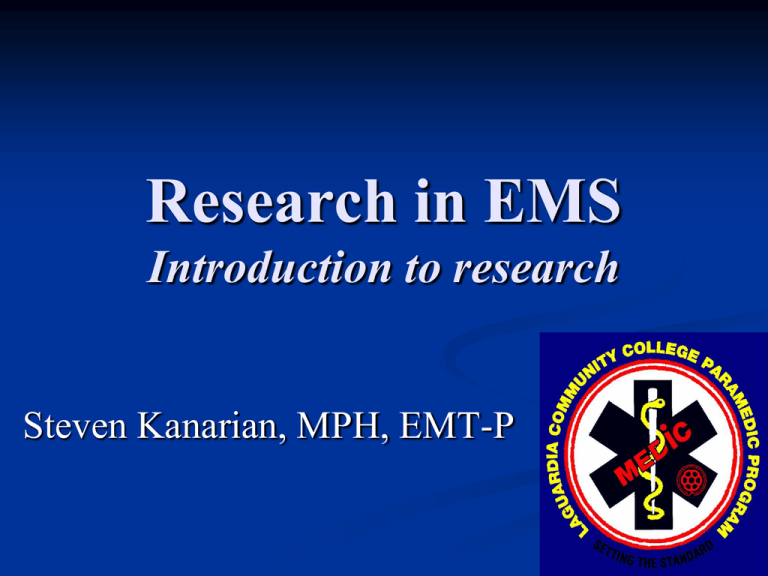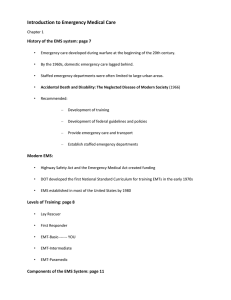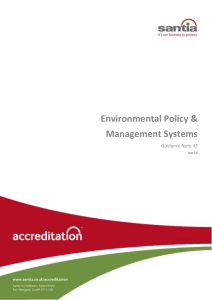click here to view Research in EMS role of EMS
advertisement

Research in EMS Introduction to research Steven Kanarian, MPH, EMT-P Objectives Understand research steps Types of research Understand the need for research in EMS Role of provider in research What is research? Research is learning, seeking the truth We learn and gain experience every day. Research is observational or experience Anecdotal experience Systematic observation Hypothesis testing What is evidence based medicine? Aims to apply evidence gained from the scientific method to certain parts of medicine Evaluates: Quality of evidence Risk/benefit of treatment Uses current best evidence to guide care IOM recommends: Separate institute of emergency medicine research needed The Future of Emergency Care in the US: The Institute of Medicine Subcommittee on Prehospital Emergency Medical Services, (Ann. Emerg. Med. 2006;48:126-130) Challenge for EMS is to measure outcomes. Types of research Retrospective – looking back Prospective – designing a study protocol, collecting data in the future Blinded Randomized Experimental Types of research Retrospective – looking back Types of research Prospective – designing a study protocol, collecting data in the future Types of research Blinded Types of research Randomized Types of research Experimental Literature Review Used to define and explore the research topic Literature Search Discovers existing research Will help refine questions CINAHL, MEDLINE, Science Direct, PubMed Keywords and review articles Note bibliographies and authors Search will guide your project Developing a Question Developing the question Narrow question Consider past research New trends Consults experts Determining the type of study Resources Data availability Registry Call report review Question being asked Staffing Developing the Research Project Developing the methods Power calculation IRB approval Interacting with providers Conducting a pilot study Implementing study/analyze data Reporting the findings CME or local conference PCRF Forum at JEMS NAEMSP, NAEMSE conferences Article or abstract publication Pre-hospital Emergency Care (PEC) Annals of Emergency Medicine (AEM) Recommended reading…. An Introduction to EMS Research Lawrence H. Brown, Elizabeth Criss, N. Heramba Prasad Prentice Hall, Brady publications Reviewing Research Article Journal/Title Authors Type of study Who is doing/paying for study Methods Findings Conclusions Reading the Literature Critical analysis do the numbers add up do the numbers make sense do the results answer the question is the data extrapolated too far Evaluating An Article Evaluate demographics similar system configuration similar patient distribution Evaluate numbers enough patients right equipment comparing apples to apples Reading the Literature Limitations to existing literature no perfect project acknowledge strengths & weaknesses Incorporating into practice influence current practice how much is enough evidence-based practice Participating in research is important to current practice to future practice to establishing the professionalism of EMS Begin with reading the literature books journals electronic media Be critical of research not all published research is good research not all published research is valuable research not all published research is reported correctly Hold people accountable Research is the future of EMS validates promotes improves Let’s take a closer look Significant research in EMS Research: General Principles and Emergency Medicine Application John B. McCabe, MD, FACEP Problems with Research in Emergency Medicine Sporadic patient load Pre-defined treatment Medical records Multi-institutional cooperation may be difficult Funding ?? What are these??? MAST Pants Thought to….. Auto-transfuse 2 units of blood Increase PVR Raise BP “What happened???” Stabilize pelvic fractures Control surface bleeding Widely used in 1980’s-1990’s What happened… STUDY: Randomized trial of pneumatic antishock garments in the prehospital management of penetrating abdominal injuries MDWilliam H Bickell*, MDPaul E Pepe †, ‡, , MDMark L Bailey*, MDCharles H Wyatt* and MDKenneth L Mattox* *Department of Surgery, Baylor College of Medicine, Ben Taub General Hospital, Houston, Texas, USA †Department of Medicine, Baylor College of Medicine, Ben Taub General Hospital, Houston, Texas, USA ‡City of Houston Fire Department Emergency Medical Services, Houston, Texas, USA Randomized Study Alternate day randomization (control, N=104, MAST, N = 97) The results demonstrated no significant difference in the survival rates of the control and PASG treatment groups (81 of 104 vs 67 of 97). “ From these data we conclude that, contrary to previous claims, the PASG provides no significant advantage in improving survival in the urban prehospital management of penetrating abdominal injuries. “ The Ontario Prehospital Advanced Life Support Study (OPALS) Ian G Stiell MD, MSc, FRCPC *‡§, George A Wells PhD ‡§, Daniel W Spaite MD ¶IIII, Graham Nichol MD, MPH, FRCPC #§, Bernard O’Brien PhD**, Douglas P Munkley MD, MCFP(EM)¶, Brian J Field EMA III II, Marion B Lyver MD, FRCPC, MCFP(EM)#, Lorraine G Luinstra BScN, MHA¶, Eugene Dagnone MD, FRCPC‡‡, Tony Campeau BSc§§, Roxanne Ward RN§, Steve Anderson BSc§ and For the OPALS Study Group OPALS Largest ALS study in the World Will involve 25,000 cardiac arrest, trauma and respiratory patients “Before and after”study 8 years of collecting data Outcomes measured Disease Specific Quality of Life Respiratory Distress and Trauma areas Process of care measures (rates of success failure for skills) Response time Length of stay Unique Study Before phase Rapid Defib phase ALS phase Able to compare the incremental improvement Proved AED Defibrillation saves lives Medics treat respiratory distress and chest pain effectively Sets bar for other large scale prospective studies 1st responders increase survival January 1, 1999 to January 31, 1995 5,335 Cardiac Arrest Patients 46.8% witnessed by bystanders 14.5% received bystander CPR 25% received 1st responder CPR Increased save rate to 3.5 and 8.5% for VFib Occupational injuries among EMS personnel McGuire, Hunting, Guidotti, Smith Prehospital Emergency Care 2005;9: 405-411 Objective Describe the epidemiology of occupational injuries among EMS personnel, calculate injury rates, and compare findings with other occupational groups. EMS Providers treat 22 million patents per year, little known about our injuries Methods Retrospective review of injury records kept by two urban agencies 617 cases over 3 years Injury rate was 34.6 per 100 employees Most often sprains, strains and tears Back most frequent 277 cases resulted in lost days from work Conclusions Injuries greater for EMS than any other industry in 2000 according to DOL statistics Recommended funding and further research are critical to define problem and prevent injuries What would you like to study?? Emerging topics Intubation by paramedics Pain management EMS Skill retention System design Clinical interventions Where to start? Descriptive study- what are we doing for our community/school? Where are we making a difference? Pain management Injury prevention Reduced response time Reduced health care costs Research starts with a question and a desire to learn the truth. We know EMS makes a difference, let’s prove it!! Please leave a comment… Questions about research How to review an article





